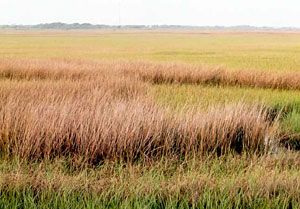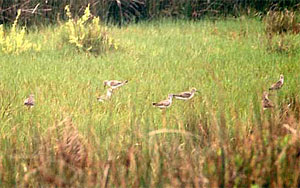Bolivar Peninsula
On the 16th we set off aiming for the southern tip of Bolivar Peninsula. First decent bird we had was at the beginning of the peninsular – a low-hunting male Northern Harrier. As we continued along the coast road (route 87) we both noticed a road sign saying Yacht Basin Road. Back at Boy Scout Woods there is a noticeboard detailing what birds are about in the area. This board had Yacht Basin as a site for Seaside and Nelson's Sharp-tailed Sparrow. Seaside is usually easy to get around here but Nelson's would be new for both of us and is a bird we really wanted. So, I 'firmly decelerated' and did a quick U-turn. As we drove down Yacht Basin Road we recognized it as a place we'd been to last year in the hope of a Nelson's. It was here last year we had had our first Clapper Rail. This year we arrived quite early in the morning, about 8.30am and conditions were calm – last year we arrived around midday and it was quite windy.

Nelson's Sharp-tailed Sparrow site
We parked by the roadside, managing to miss the sign saying 'No Parking' and proceeded to scan the area. Willets were easy to see but not nearly as abundant as last year and our first sparrow was obviously a Seaside. A second sparrow flew up from one cluster of reeds and landed on the edge of another. We thought it must be another Seaside but still checked it - shock! - it was a spring-plumaged Nelson's Sharp-tailed Sparrow. Just as it was identifed it dived for cover. We were pretty happy but then another appeared and sat on top of a reed and showed beautifully. After a few seconds it flew and looked very yellow to the naked eye. It dived into the nearby reeds and disappeared. We were delighted with that but then it started to sing! The hissing song could be heard clearly and made the experience just about perfect. In total we had four birds seen and two heard singing.
In an excellent mood we continued along the coast road towards Bolivar Flats Shorebird Sanctuary, a large area of sandy shore and marsh owned by Houston Audubon. Last year it was a trip highlight and we hoped this year would be just as good.
It was quite exciting to turn down Rettilion Road and drive onto the beach and along the sand to the famous pilings. There were rumours of a 'portaloo' seen here yesterday but it had gone when we arrived!
As we started the walk through the pilings to the best bird area we met a US postal worker (at least that's what his shirt said) named Paul. He was waiting for some friends who hadn't arrived and asked to join us to aid him in identifying the mass of birds that usually populates the peninsular. Of course we were delighted to have him along and the three of us headed towards the flocks.
As with last year the birds were present is great numbers. I set up each species in the 'scope, Helen had a look and then Paul had a look whilst Helen explained to him what he was looking at: Least Royal, Capsian, Gull-billed, Sandwich and Forster's Terns; Herring, Laughing and Ring-billed Gulls; Black-bellied, Semipalmated, Wilson's, Piping and Snowy Plovers (only one of the latter as last year); Brown and American White Pelicans; Dunln, Sanderling, Long and Short-billed Dowitchers, Red Knot, Ruddy Turnstone, American Oystercatcher, Western and Semipalmated Sandpipers; Black Skimmer, Reddish Egret, Great Blue Heron and, of course, the flocks of American Avocets – not as many as last year but I estimated there were a good 4000+ present. This really is a place everyone should visit – the spectacle should be experienced by every birder.
Two bonus birds, species not seen here last year, were found: a brief view of a running Clapper Rail and, also new for the ABA list, a pair of Horned Larks which mostly appeared to be fighting but when they landed the male drew himself up, chest out, horns up, and displayed to the female.

Greater and Lesser Yellowlegs
As we drove away from the area, and back along Rettilion Road, we came across a group of 'legs' - Greater and Lesser Yellowlegs – in marshy pool. As usual they were skittish birds but showed well as long as we stayed in the car
Finally, as we had almost reached route 87, another male Northern Harrier flew in front of us and then along side as it quartered the marsh and scared the yellowlegs.

